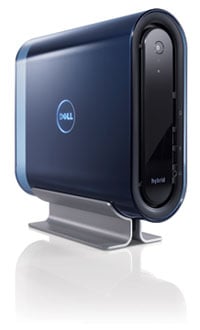Dell Studio Hybrid Small Form Factor Desktop
Components, Design and Features

 The front side of the system has an integrated 7-in-1 flash card reader, a pair of USB2.0 ports, a headphone jack and slot load DVD player, which as we mentioned can also be upgraded to Blu-ray. There is also a power button, CD/DVD eject button and hard drive indicator icon, all which light up along with the Hybrid logo and Dell's logo on the side of the box.
The front side of the system has an integrated 7-in-1 flash card reader, a pair of USB2.0 ports, a headphone jack and slot load DVD player, which as we mentioned can also be upgraded to Blu-ray. There is also a power button, CD/DVD eject button and hard drive indicator icon, all which light up along with the Hybrid logo and Dell's logo on the side of the box.
On the backside of the system, is a surprising multitude of I/O options, including both DVI and HDMI out, which clearly spells Home Theater PC in our book. Also on the back I/O plate are three more USB2.0 ports, line in/out audio jacks, the Gig-E port, and optical S/P DIF audio port and the AC adapter power plug. Speaking of which, the included power brick with the Studio Hybrid is surprisingly small and comes with a built-in rubber strap that allows you to easily bundle any extra cabling to keep it neatly tucked away in your install area. In addition, the power cable itself has a nice right angle molded plug on the end of it which allow it to wrap right up against the backside of the brick, again for easy securing with the integrated strap. Dell clearly was focused on design elegance with the Studio Hybrid and we were impressed with the system's over all build quality in general.
Even working inside the system is a pleasure (especially considering its size), for the advanced end user that might have a need to upgrade primary components like the hard drive or system memory.
With the removal of just two screws, your inside the machine and from there, you've got one more screw to go, to remove the hard drive/optical drive cage (top right) to gain access to the motherboard area. Once inside you can see there are standard notebooks SODIMMs memory sticks installed, as well as a standard 2.5" spinning hard drive mounted in the drive cage. A few more screws mount the heatsink assembly on top of the processor socket, though these are removed relatively easily, should you want to upgrade the CPU. Just remember you might need a BIOS update if you don't upgrade to a processor that isn't currently an option on Dell's site for the machine.
A note on multimedia performance and digital video playback -
Dell built the current generation Studio Hybrid upon Intel's GM965 Express mobile chipset with integrated X3100 graphics. The machine certainly doesn't have any sort of real 3D gaming capability but along with the Intel Core 2 Duo dual core processor under its hood, this system should handle most multimedia and business desktop tasks with relative ease, including playback of full 1080p resolution HD video sources.
In that vein, we should note that you'll want to disable DirectX processing in Windows Media center, or another 3rd party player of your choice, if you're going to be playing back full 1080p video. Intel's integrated graphics drivers simply are still not up to par with the X3100 core in the 965 chipset. Since the chipset doesn't offload many HD video decode functions in hardware, playback with DirectX processing enabled is pretty spotty. We turned this off and with the machine relying on the host CPU entirely, 1080p content played smoothly. Dell also bundles their Media Direct multimedia player in with the OS installation of the Hybrid and at its default setting, the machine had no problem playing back 1080p content. Incidentally, with a 1080p clip running, we observed around 40% CPU utilization and the machine was still very much responsive. That said, we feel strongly that Dell would do well to upgrade the Studio Hybrid line with Intel's latest G45 mobile chipset with GMA X4500 integrated graphics and the Centrino 2 platform. The G45 has full offload of the HD video decode stack and a bit more 3D graphics horsepower as well.














